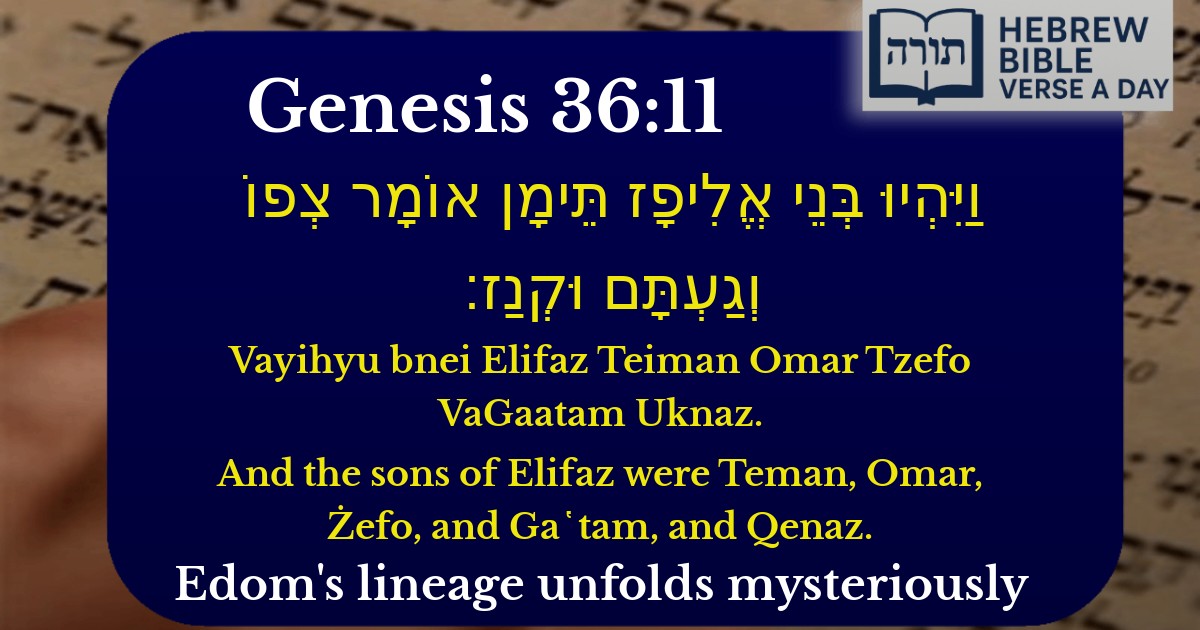Frequently Asked Questions
Q: Who were the sons of Elifaz mentioned in Genesis 36:11?
A: The sons of Elifaz were Teman, Omar, Tzfō, Ga῾tam, and Qenaz. Elifaz was the son of Esav (Esau), making these figures important in understanding the lineage of Esav's descendants as recorded in the Torah.
Q: Why does the Torah list the descendants of Esav (Esau) in Genesis 36?
A: The Torah lists Esav's descendants to show the fulfillment of Hashem's blessing that Esav would become a great nation (Genesis 27:39-40). Additionally, Rashi explains that these genealogies are recorded to distinguish the Edomite kings and chiefs from the lineage of Yaakov (Jacob), emphasizing the separate paths of these two nations.
Q: What is the significance of the names of Elifaz's sons in Genesis 36:11?
A: The names of Elifaz's sons represent the clans and nations that descended from Esav. For example, 'Teman' later became associated with a region in Edom (see Obadiah 1:9). The Midrash sometimes links these names to traits or historical events, but primarily, they establish the genealogical record of Esav's family.
Q: How does Genesis 36:11 connect to later parts of Tanach?
A: Some of these names reappear in later books, such as the prophecies against Edom (e.g., in the book of Obadiah). Knowing their origins in Esav's lineage helps us understand the historical and prophetic context when these nations are mentioned in Nevi'im (Prophets) and Ketuvim (Writings).
Q: Why does the Torah mention Qenaz if he was not originally listed as Elifaz's son in earlier verses?
A: Rashi notes that Qenaz was actually the son of Elifaz's concubine, Timna (see Genesis 36:12), but he is included here because he was still part of Elifaz's household and a significant figure in Edom's lineage. The Torah sometimes groups family members together even if their status differs.


Introduction to the Verse
The verse lists the sons of Elifaz, who was the firstborn son of Esav (Esau) and one of the chiefs of Edom. The names of Elifaz's sons—Teman, Omar, Żefo, Ga῾tam, and Qenaz—are significant in understanding the lineage and influence of Esav's descendants, as well as their historical and prophetic roles.
Rashi's Commentary
Rashi (on Bereishit 36:11) explains that these names represent the chiefs and nations that descended from Esav. He notes that Teman is associated with the land of Edom, as later referenced in the prophecies of Ovadiah (1:9) and Yirmiyahu (49:7). Rashi also mentions that Qenaz is noteworthy because Caleb ben Yefuneh, one of the meraglim (spies), was descended from him (see Bamidbar 32:12).
Midrashic Insights
The Midrash (Bereishit Rabbah 82:13) elaborates on the significance of these names, suggesting that they reflect the character and destiny of Esav's descendants:
Rambam's Perspective
While Rambam does not comment directly on this verse, his principles of hashkafah (Jewish thought) emphasize that the Torah records these lineages to teach about divine providence and the fulfillment of Hashem's plan. The rise and fall of nations, including Edom, are part of the broader narrative of Jewish history and geulah (redemption).
Halachic and Historical Implications
The Talmud (Avodah Zarah 10b) references Teman as a place of wisdom, noting that the sages of Edom were renowned for their counsel. However, their wisdom was often used against Klal Yisrael, reinforcing the tension between these nations. Additionally, the presence of Qenazite descendants among Bnei Yisrael (like Caleb) shows the complexity of lineage and conversion in Jewish tradition.